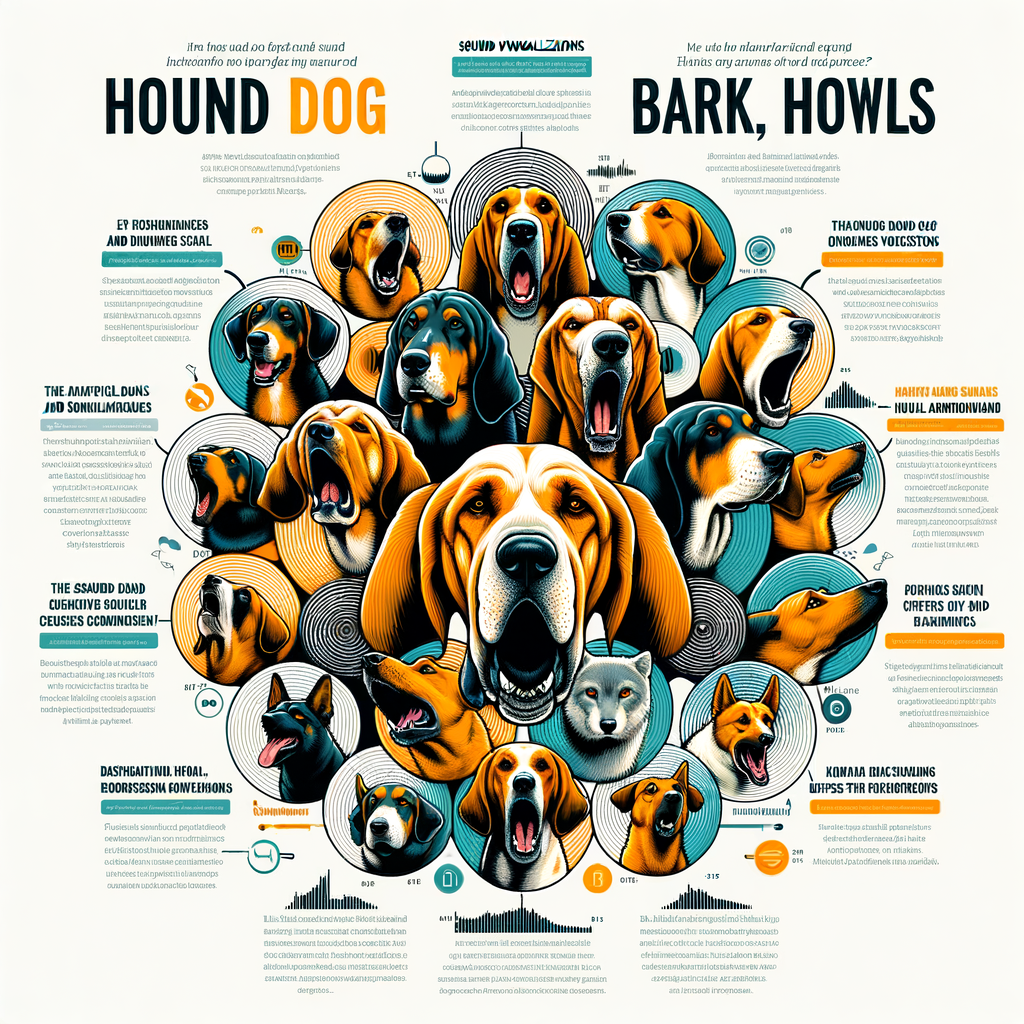
Introduction to Hound Barks and Howls
Every dog owner knows that their furry friend has a unique way of communicating. Hound dogs, in particular, are known for their distinctive barks and howls. These sounds are not just noise; they are a form of communication that carries a wealth of information. In this article, we will delve into the fascinating world of hound barks and howls, helping you understand what your dog is trying to tell you.
- Understanding the importance of dog vocalizations
- Exploring the diversity of hound dog sounds
Dog vocalizations, such as barks and howls, play a crucial role in their communication. They use these sounds to express a range of emotions and intentions, from alerting their human companions about potential threats to showing excitement or distress. Understanding these vocalizations can significantly enhance the bond between you and your hound, as you’ll be better equipped to respond to their needs and emotions.
Hound dogs are known for their rich vocal repertoire. They can produce a wide array of sounds, each with its unique meaning. The classic hound howl, for instance, is often used to signal their location to others, while a sharp, high-pitched bark might indicate excitement or alertness. By exploring the diversity of these sounds, you can gain a deeper understanding of your hound’s behavior and communication style.
In the following sections, we will delve deeper into the specifics of hound barks and howls, discussing their meanings, differences, and how they are used in communication. We will also share real-life examples and case studies to illustrate these points. So, whether you’re a seasoned hound owner or just considering adopting one, this guide will provide you with valuable insights into their unique language.
Understanding Hound Barks
When it comes to understanding our canine companions, one of the most fascinating aspects is their unique way of communication. Hound dogs, in particular, have a rich vocal repertoire, and their barks can convey a wide range of emotions and messages. Let’s delve deeper into the world of hound barks.
Hound Bark Types
Just like human voices, not all hound barks are the same. There are different types of barks, each with its unique sound and meaning. By understanding these differences, we can better understand our hound friends.
- Identifying different hound barks
- Understanding the context of each bark type
Identifying different hound barks is the first step towards understanding them. Hounds may have a low, deep bark when they are alerting their owners to a potential threat. On the other hand, a high-pitched, rapid bark might indicate excitement or eagerness to play. A long, drawn-out howl can be a sign of loneliness or boredom. It’s important to pay attention to these differences to understand what your hound is trying to communicate.
Understanding the context of each bark type is equally important. For instance, a hound’s bark when they spot a squirrel in the yard will sound different from their bark when they’re asking for dinner. The former is likely to be more intense and urgent, while the latter may be more persistent and rhythmic. By observing the situation in which the bark occurs, we can gain further insight into its meaning.
In conclusion, understanding hound barks is not just about identifying the different types of barks, but also understanding the context in which they occur. By doing so, we can better understand our hound friends and respond to their needs more effectively.
Interpreting Hound Barks
Understanding the language of hound barks can be a fascinating journey. It’s like learning a new language, where each sound has a unique meaning. Let’s dive into the world of hound barks and decode their meanings.
- Recognizing signs of aggression or fear in barks
- Decoding barks of excitement or playfulness
Aggressive or fearful barks are often loud, rapid, and high-pitched. These barks are usually accompanied by body language such as raised hackles, bared teeth, or a stiff tail. If your hound is barking in this manner, it’s essential to identify the source of their discomfort and address it promptly.
On the other hand, barks of excitement or playfulness are usually of a lower pitch and slower pace. These barks are often accompanied by a wagging tail and relaxed body posture. If your hound is barking in this manner, they’re likely inviting you to join in their fun!
Remember, interpreting hound barks is not an exact science. Each hound is unique and may express themselves differently. However, these general guidelines can help you better understand your hound’s communication and strengthen your bond with them.
Stay tuned for our next section where we’ll dive deeper into the fascinating world of hound howls!
Diving into Hound Howls
When it comes to hound dogs, their howls are as unique as they are. These howls, often heard from miles away, serve various purposes and come in different varieties. Let’s dive deeper into the fascinating world of hound howls.
Hound Howls Varieties
Just like humans have different voices and tones, hound dogs too have a range of howls. Each howl is unique and serves a specific purpose. Let’s explore these varieties and understand their unique characteristics.
- Exploring the range of hound howls
- Understanding the unique characteristics of each howl
There is a wide range of hound howls, each with its own distinct sound and purpose. Some hounds have a high-pitched, almost musical howl, while others produce a deep, resonant sound. There are also howls that are short and sharp, and others that are long and drawn out. These variations in howls are often influenced by the breed of the hound, their environment, and their emotional state.
Each hound howl has unique characteristics that make it distinct. For instance, a long, drawn-out howl is often a call for the pack or a way to communicate over long distances. On the other hand, a short, sharp howl might be a warning or a sign of excitement. By understanding these characteristics, we can better interpret what our hound dogs are trying to communicate.
Understanding the range and unique characteristics of hound howls is the first step in decoding their communication. In the next section, we will delve deeper into understanding hound howls and their meanings.
Understanding Hound Howls
When it comes to understanding hound howls, it’s important to remember that each howl has a unique meaning. Let’s dive into the details of two types of howls: long, sustained howls and short, sharp howls.
- Decoding the meaning behind long, sustained howls
- Interpreting short, sharp howls
Long, sustained howls are often a form of communication between hounds. They use these howls to convey messages to other dogs that might be miles away. These howls can mean a variety of things, such as “I am here” or “This is my territory”.
According to a study conducted by the Canine Communication Research Centre, long, sustained howls are also used by hounds to express their emotional state. For example, a hound may howl in a long, sustained manner when it is feeling lonely or anxious.
On the other hand, short, sharp howls are typically a response to sudden, unexpected stimuli. This could be anything from the sound of a doorbell to the sight of an unfamiliar person or animal.
Short, sharp howls can also be a sign of excitement or playfulness. For instance, a hound might emit a series of short, sharp howls when it is playing with its owner or other dogs.
In conclusion, understanding the meaning behind hound howls can help us better communicate with our furry friends and respond to their needs more effectively. Remember, long, sustained howls often indicate communication or emotional expression, while short, sharp howls are usually a response to sudden stimuli or a sign of excitement.
| Type of Howl | Meaning |
|---|---|
| Long, sustained howls | Communication, territorial claims, emotional expression |
| Short, sharp howls | Response to stimuli, excitement, playfulness |
Howl Differences in Hounds
Every hound breed has a unique voice, just like humans. This uniqueness becomes even more pronounced when we listen to their howls. Let’s explore the fascinating world of hound howls and understand what makes each breed’s howl distinct.
- Comparing howls between different hound breeds
When it comes to hound breeds, the diversity is quite astounding. From the deep, resonant howl of the Bloodhound to the melodious baying of the Beagle, each breed has a distinctive howl. Let’s delve deeper into this.
| Breed | Howl Description |
|---|---|
| Bloodhound | Their howl is deep and resonant, often described as a ‘bay’. |
| Beagle | Beagles have a melodious howl, often described as a ‘song’. |
| Basset Hound | Their howl is low-pitched and mournful, often described as a ‘wail’. |
These are just a few examples. The howl of a hound is a complex combination of breed characteristics, individual personality, and environmental factors.
- Understanding how age and health affect howls
Just like humans, a hound’s voice changes with age. Puppies have a high-pitched, yappy howl, while adult dogs have a deeper, more resonant howl. Senior dogs may have a weaker, more subdued howl due to age-related health issues.
Health also plays a significant role in a hound’s howl. A hound suffering from a respiratory illness, for example, may have a wheezy, strained howl. On the other hand, a healthy hound will have a clear, strong howl.
Understanding the nuances of your hound’s howl can help you gauge their health and well-being. So, the next time your hound raises their voice, listen closely. They might be telling you more than you think!
Hound Dog Communication
While hounds are known for their unique vocalizations, their communication extends far beyond their barks and howls. Understanding your hound’s communication is crucial to building a strong bond with your pet and ensuring their well-being.
Non-Vocal Communication
Non-vocal communication in hounds is just as important as their vocal signals. It involves body language and behavioural cues that can tell you a lot about what your hound is feeling or trying to convey.
- Understanding Body Language in Hounds
- Recognizing Signs of Stress or Discomfort
Body language is a significant part of non-vocal communication in hounds. A relaxed hound will have a loose, wagging tail and relaxed ears. On the other hand, a hound that is scared or anxious may tuck its tail between its legs, flatten its ears, and avoid eye contact. Observing your hound’s body language can help you understand their emotions and needs.
Recognizing signs of stress or discomfort in your hound is crucial for their well-being. Signs of stress can include excessive panting, pacing, whining, or changes in eating habits. If your hound is showing these signs, it’s important to identify and address the cause of their stress or discomfort.
Understanding your hound’s non-vocal communication can strengthen your bond with your pet and help ensure their happiness and well-being. Remember, every hound is unique, so it’s important to spend time with your pet and learn to understand their specific communication cues.
Vocal Communication
When it comes to hound dog communication, vocalizations play a crucial role. Let’s delve into the symphony of sounds these dogs produce and understand their significance.
- Decoding the symphony: a deep dive into hound barks and howls
- Understanding the role of barks and howls in communication
Every hound dog owner has experienced the unique symphony of barks and howls that these dogs are known for. But have you ever wondered what these sounds mean? Let’s decode this symphony.
Barks and howls are not just random noises. They are a form of communication. A hound’s bark can vary in pitch, volume, and frequency, each variation conveying a different message. For instance, a high-pitched bark often signifies excitement or eagerness, while a low-pitched bark might indicate a threat or discomfort.
Howls, on the other hand, are often used for long-distance communication. Hounds use howls to call out to their pack, express loneliness, or even to alert their owners of something unusual. The melodious howl of a hound can travel great distances, making it an effective communication tool.
Barks and howls are more than just noise; they are a hound’s way of expressing itself. Understanding these vocalizations can help us better understand our furry friends and their needs.
Barks are typically used for short-range communication. They can convey a variety of emotions and intentions, from excitement and playfulness to fear and aggression. By paying attention to the tone, pitch, and frequency of a hound’s bark, we can gain insights into its emotional state and intentions.
Howls serve a different purpose. They are primarily used for long-distance communication. A hound may howl to call out to its pack, express loneliness, or alert its owner to something unusual. Understanding the meaning behind these howls can help us respond appropriately to our hounds’ needs.
In conclusion, understanding the symphony of hound barks and howls is a key aspect of understanding and caring for these unique dogs. By paying attention to their vocalizations, we can better understand their needs, emotions, and intentions, leading to a stronger bond between us and our furry friends.
Case Studies: Real-Life Examples of Hound Communication
Now that we’ve learned about the different ways hounds communicate, let’s look at some real-life examples. These case studies will help us understand how hounds use their barks and howls in different situations.
- Case study 1: Understanding a hound’s change in bark
- Case study 2: Deciphering a hound’s howl
Meet Max, a three-year-old Basset Hound. His owners noticed a change in his bark. Instead of his usual deep, resonant bark, Max started to produce a high-pitched, frantic bark. Concerned, they decided to consult with a dog behaviorist.
The behaviorist observed Max and found that his new bark was a response to a new cat in the neighborhood. Max was trying to communicate his discomfort and assert his territory. This case study shows us that changes in a hound’s bark can indicate changes in their environment or emotional state.
Next, let’s consider Bella, a five-year-old Bloodhound. Bella’s owners were puzzled by her persistent howling every evening. They couldn’t figure out what was triggering this behavior.
Upon consulting a canine expert, they discovered that Bella was responding to a distant siren sound that her owners couldn’t hear. Bella’s howling was her way of joining in the distant call, a behavior rooted in her hound ancestry. This case study illustrates how hounds use howling as a form of long-distance communication.
These case studies show us that understanding a hound’s bark or howl can provide valuable insights into their feelings and environment. By paying attention to these vocal signals, we can better understand and respond to our hound’s needs.
Key Takeaways: Decoding the Symphony of Hound Barks and Howls
As we conclude our exploration into the world of hound barks and howls, let’s summarize the key points we’ve learned. This knowledge will help you better understand your hound’s unique language and strengthen your bond with your furry friend.
- Understanding the importance of vocalizations in hounds
- Recognizing the different types of barks and howls
- Applying this knowledge to better understand and communicate with your hound
Hounds use barks and howls as their primary means of communication. These vocalizations can convey a wide range of emotions and messages, from excitement and happiness to fear and distress. Recognizing the importance of these sounds is the first step towards understanding your hound’s needs and emotions.
Not all barks and howls are the same. Hounds have a diverse vocal repertoire, with each sound carrying a different message. For instance, a high-pitched, rapid bark often signals excitement, while a long, drawn-out howl may indicate loneliness or distress. By learning to recognize these different sounds, you can respond more effectively to your hound’s needs.
Understanding your hound’s vocalizations can significantly improve your communication with them. By responding appropriately to their barks and howls, you can reassure your hound, meet their needs, and strengthen your bond with them. Remember, communication is a two-way street – your hound is always trying to understand you, too!
In conclusion, understanding your hound’s barks and howls is a fascinating journey that can deepen your relationship with your pet. Remember, every hound is unique, and their vocalizations can vary. So, keep an open ear and an open heart, and you’ll soon find yourself conversing fluently in your hound’s language.








